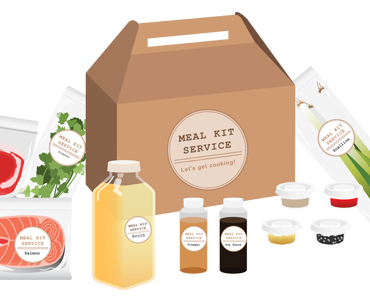
Meal kits: convenience vs. packaging
By Carol Zweep
Food Trends Packaging meal kits packaging wasteThe popularity of meal kits leaves us with a dilemma: weighing personal convenience against contributing to the packaging waste issue

By Carol Zweep
You have been working late and you need to make dinner. You didn’t have time to look up a recipe, make a list of groceries or go to the store. Imagine coming home and finding a box at your doorstep with all the ingredients and a recipe for an exotic, healthy meal. With the purchase of a meal kit, you have enjoyed the experience of cooking and consuming a meal that you might not otherwise try at home.
According to Mintel (Home Meal Replacement Canada 2017), the meal kit trend is growing, and about 24 per cent of Canadian consumers say they are interested in a meal delivery service from home meal replacement retailers. But the popularity of meal kits leaves us with a dilemma: weighing personal convenience against contributing to the packaging waste issue.
Packaging prevents food spoilage, and ensures food quality and safety. For the meal kit, this entails packing ingredients in  plastic bags and jars that are placed in an insulated cardboard box with ice packs. Packaged portions means there are no leftovers. The decrease in food waste and the lack of extraneous ingredients is appealing. However, overpackaging can lead to additional costs and a negative impact on the environment.
plastic bags and jars that are placed in an insulated cardboard box with ice packs. Packaged portions means there are no leftovers. The decrease in food waste and the lack of extraneous ingredients is appealing. However, overpackaging can lead to additional costs and a negative impact on the environment.
What is the magnitude of food waste? In Canada, $31 billion worth of food ends up in landfills or composters each year, with 47 per cent of waste happening in the home (Value Chain Management International, 2014). How does the environmental impact of food waste compare to packaging waste? The How Packaging Contributes to Food Waste Prevention study (Denkstatt, 2014) found that packaged fresh goods have a smaller environmental footprint than unpackaged food, even if the packaging is not recycled. Proper packaging can result in fewer greenhouse gas emissions. Although more packaging is used, less food is wasted, leading to a lower overall carbon footprint. According to the Industry Council for Research on Packaging and the Environment (INCPEN), “Ten times more resources — materials, energy, water — are used to make and distribute food than are used to make the packaging to protect it.”
Meal kit makers acknowledge that packaging is a problem and are making efforts to address this issue. One meal kit delivery company (HelloFresh) worked with Cascades Inc. to design a more sustainable insulated container. Both the corrugated box and insulator are made with 100-per-cent recycled paperboard, mostly FSC-certified by the Rainforest Alliance.
NOVA Chemicals Corporation, a plastic resin producer, is helping develop sustainable packaging for the fast-growing meal kits industry. NOVA has designed recyclable film structures that have the tough, durable properties required for food ecommerce. The company has also been working on a conceptual design for the insulating vessels used to ship weekly meal kit subscriptions.
Green Chef is optimizing its delivery packaging by reducing the box size and changing the insulation so that it will be made of recycled material that is compostable. Plastic jars have also been converted to fully recyclable food-safe pouches.
Sun Basket of San Francisco has started using sustainable box liners from Sealed Air. The insulation is made from recycled paper and is recyclable as well. Since the new liner is thinner, Sun Basket was able to switch to a smaller shipping box. SPUD and Be Fresh are using renewable plant-based bags, packets and containers that are recyclable or compostable. They are using cooler packs, freezer jackets and bins that are reusable.
Consumer demand for convenient, fresh, healthy meal kits has resulted in growth of this industry sector. Delivery of safe and quality ingredients requires appropriate packaging. Under scrutiny for contributing to the packaging waste issue, meal kit producers have responded with initiatives to decrease the environmental impact by reducing the amount of packaging or developing more sustainable packaging.
Carol Zweep is senior manager, Packaging, Product Development and Compliance, for NSF International. Contact her at czweep@nsf.org
Print this page